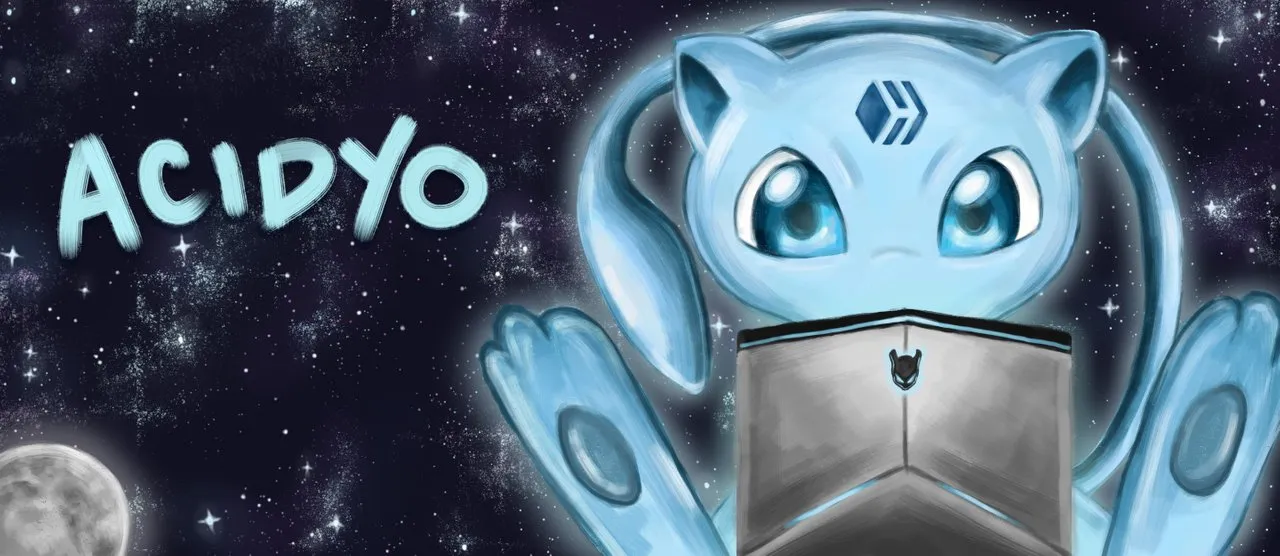I've noticed lately that there seems to be a bit of confusion both from newer users and older ones who may still think the curation curve works the same way it was before. Figured a post about it may give people an update on how it works, even if you don't particularly care much about it either cause you don't focus on curation rewards or that you don't have enough stake for them to really "matter" yet. It might give you something to keep in mind and maybe you'll notice why some accounts vote the way they do.
Basically, there's no real curation sniping anymore. In the past this meant accounts would in drones flock to certain posts by successful authors to get their votes in before bigger votes were to be cast. Then we also had the era where you got a penalty if you voted before 5 minutes of post age, etc. There's been a lot of adjustment and changes to the way curation works but I think we've landed on a good method now given the lack of bid bot votes.
Linear curation curve with a twist.
The twist is simple, if you vote on posts that are older than 24 hours, you may forfeit part of your curation returns to those who voted before 24h. Then there's a harsher penalty/forfeit after 48h/72h/etc.
At first glance this may look like it punishes people for voting on posts after 24h but at the same time if the post you're voting on has close to no voters/vote value before your vote, then there's no accounts you're forfeiting your rewards to. The difference is also pretty small after the first 1 day window, I'm not entirely sure how small but I expect it to be the worst voting on the last day so one could assume it's 7 days divided by 100, i.e. 100/7=14.2 so quite possibly a 14.28% "punishment" in curation rewards after the 1st day, double that for the 2nd day, etc.
These numbers I think would only make sense if looking at examples of same sized accounts. For simplicity's sake let's say the first account that voted within 24h has 100k HP and is about to receive 1 HP in rewards after the post paid out, if another account with 100k HP (and the same vote strength) were to vote after 24h, the first account could receive 14.28% of his 1 HP curation reward return thus resulting in the second account only receiving ~0.86 Hive.
So the size of the previous voters matter and at the same time the day of when you placed your vote matters. Naturally this means that if a post has great rewards already from big voters, the accounts voting late and being smaller won't lose out too much rewards in terms of hive but in terms of percentages it might be quite a lot but still with certain boundaries. I'm not going to get too much more into this as I'm not 100% certain on the way it works and how it may differentiate between different sizes accounts exactly and if it is exactly 7 days or if it's 6.5 days that the partitions are divided in, etc. You at least may get an idea of how it works now.
If you're an account who usually votes on posts before they hit 24 hours age, you can rest assured that your curation returns should be at the optimal APR which is at around 8.5% currently I believe.
The other factor that may change your returns are downvotes.
If you are constantly voting up posts that for one reason or another get downvoted this will also affect your curation rewards naturally.
Seeing as there's not too many who are aware of the recent changes to curation it also shows that a lot of curation trails and autovotes may not be set up to optimize curation returns. I don't think this is a big problem, if you're not around to keep up on big changes and to adjust your autovotes here and there then I don't mind manual voters getting a bit higher curation returns, even if just temporary. At the same time it can also affect the trails and autovoters if they keep voting on posts with low to no effort or authors that may have become bad actors but they're not around to be aware that some of their votes are returning no curation rewards or heavily penalized ones.
Yesterday I wrote a post about downvotes and how some like to point towards the use of them in an effort to pain the downvoter as bad people because they're doing it to increase their returns. If you think about it, those rewards that get returned from downvotes are distributed equally with everyone else. The blockchain doesn't keep track of who downvoted what and give the downvoter the rewards it returns to the pool, in that case you may start to wonder if the motives are that but considering how much active stake there is in total (I think about 200m HP) it makes little sense for me as a 340k HP account to go out and downvote ~4 posts per day or however much my downvote mana would afford just so those $20 in rewards were to be redistributed to literally all other accounts receiving curation rewards. Spending that amount of time looking for viable posts to upvote, I could easily just throw a few votes on splinterlands content to more aggressively change my returns.
With that I wanted to show you some comparison screenshots of one of the best examples of accounts that are potentially taking advantage of these rules for their own gain and how you can see the big difference in real time. Hivestats by @leofinance is one of the only tools I know to date that gives you live APR of your curation rewards and also shows efficiency of your upcoming curation rewards of the week, meaning you can see which posts your votes have landed on and why they're returning higher or lower rewards depending on what you should get at 100% efficiency, i.e. 50% of your vote back.
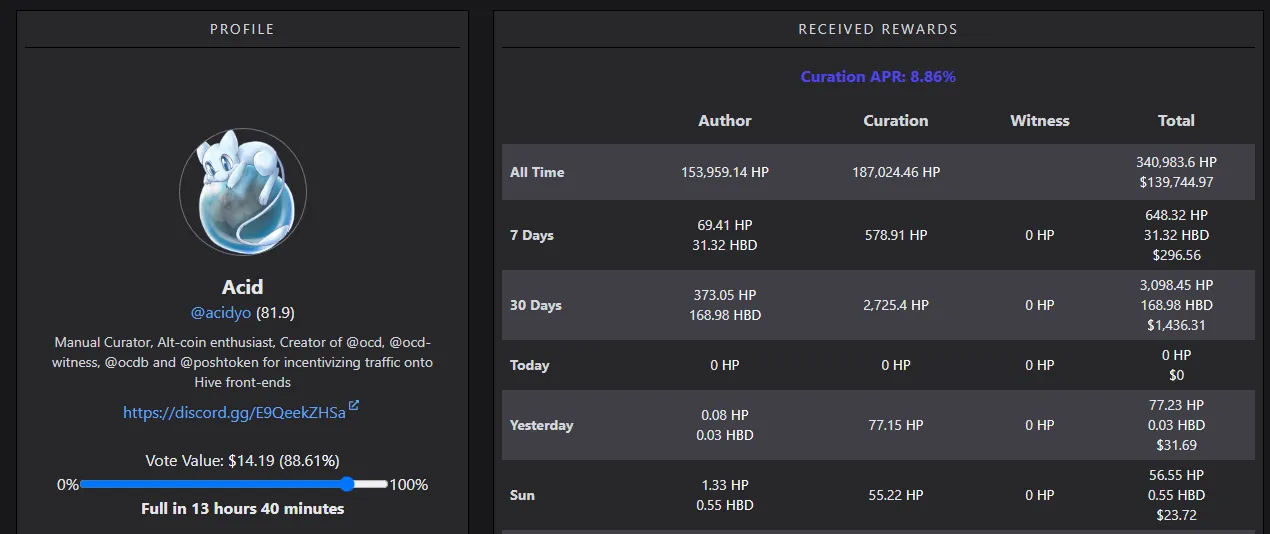
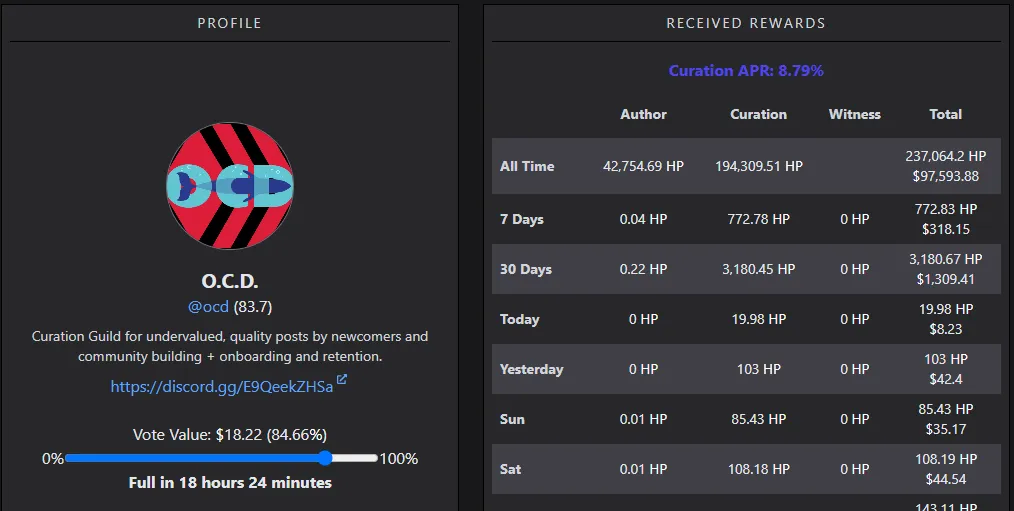
Here's a couple screenshots showing mine and @ocd's curation APR the previous week worth of rewards. It shows it's a little bit above the norm which I believe is 8.5%, if you go down on the page you can see why that is the case:
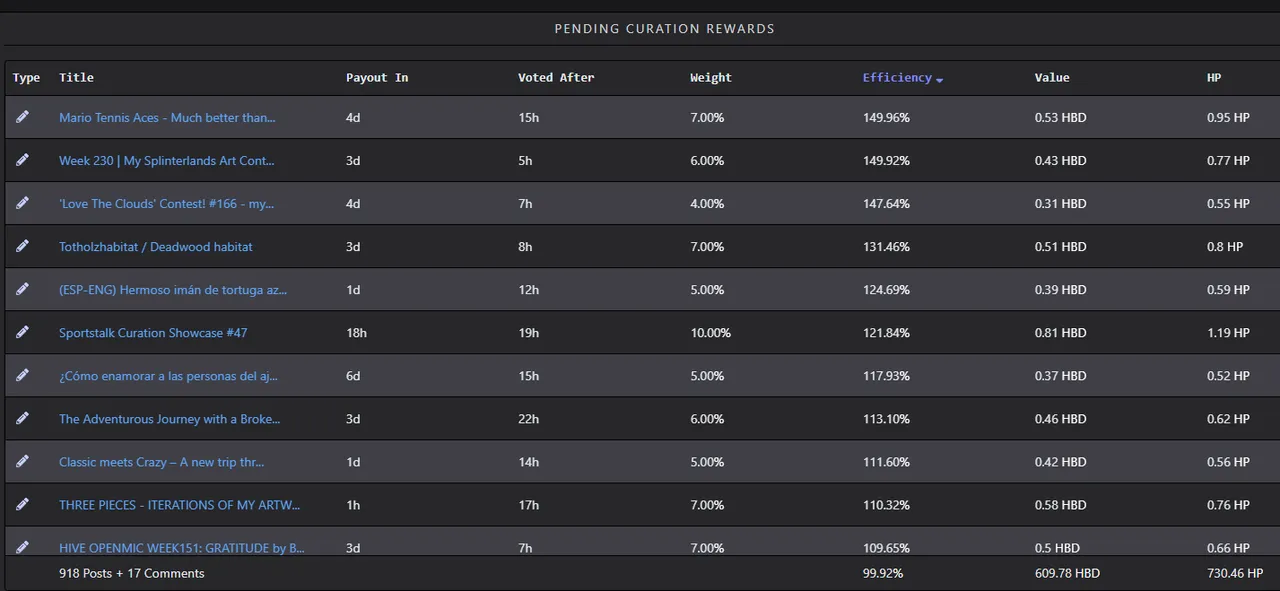
Checking on the posts with the highest efficiency first you can see that there are quite a few posts we've voted that must've received upvotes after 24h of age whereas our votes landed before the posts hit 24h. Let's take a look at the first post.
With the hiveblockexplorer tool by @penguinpablo you can also check vote history better (hiveblocks used to have this function in the past): @seryi13/mario-tennis-aces-much-better-than-i-expected-en-es
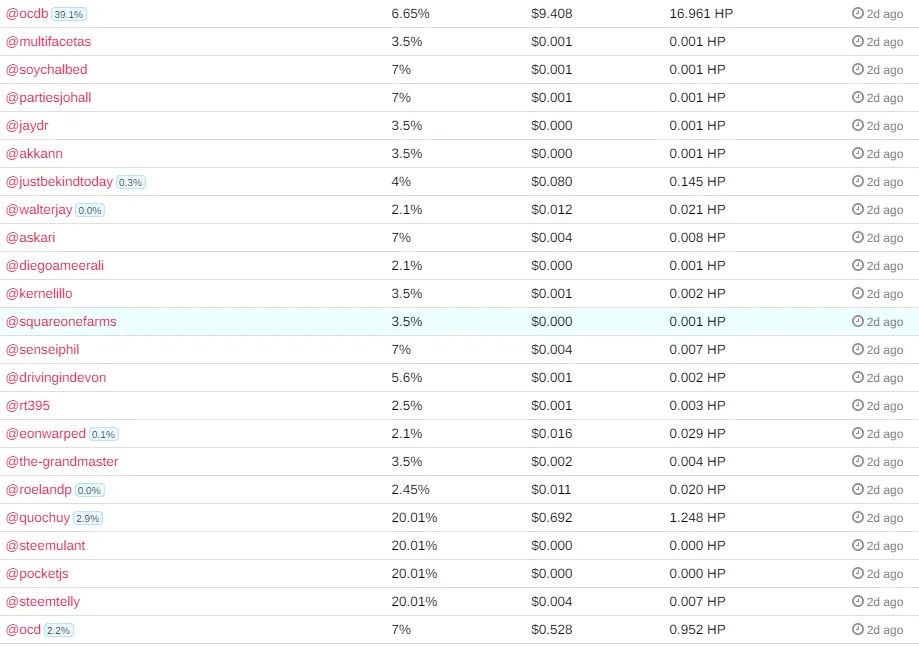
Here's a snippet of some of the votes from down to up you can see @ocd and then part of our trial and @ocdb following the trail. It shows the age of when the vote was cast which means it was about 15 hours of the posts's age as hivestats confirmed. So the question we're wondering is, what caused our pending curation returns to be higher?

It seems the reason is that @tipu cast a vote, apparently from a command from one of their curator who seemed to have trouble getting it to work on the first day as can be seen in the comments of the post:

Checking the posts with the least efficiency first you can see that we don't always vote on posts within the first 24h and there's even a post at the top that was reported for abuse that we downvoted and dealt with which resulted in 0 curation returns:
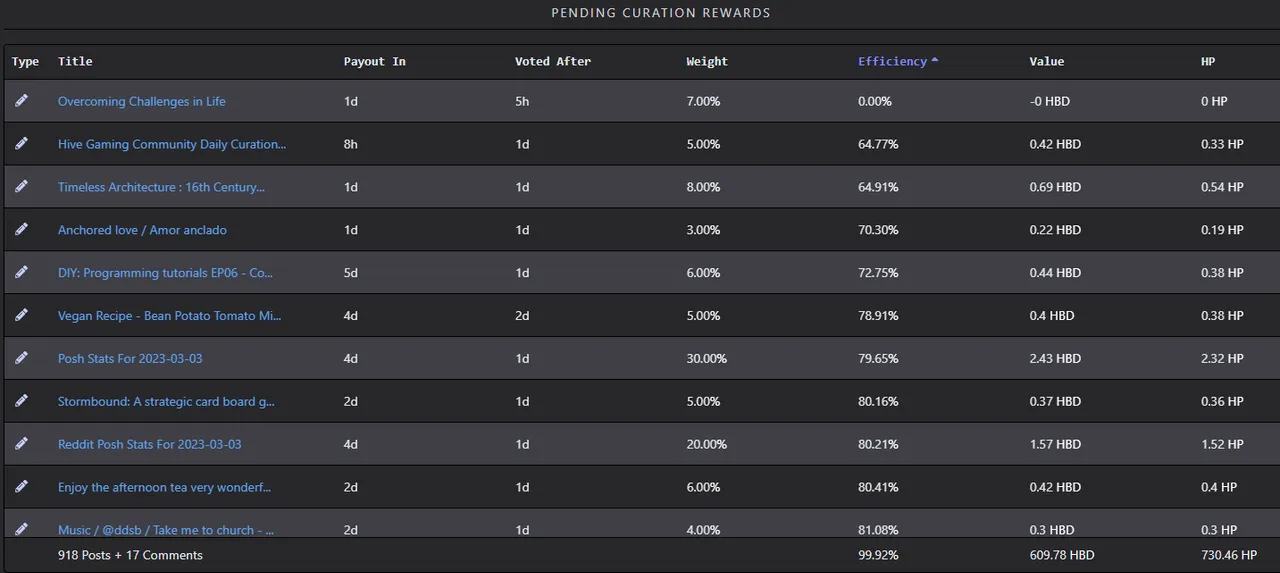
So overall it's a pretty nice system we have going at the moment, linear curve means that everyone earns equally for the amount of stake they have compared to some dumb quadratic curves we used to have in the past or nonlinear that made it hard for smaller accounts to see if they're doing any difference with their votes. It also goes to show why you should be active with keeping up to date with the rules of the chain and at the same time also staying up to date with the people you may be supporting without having checked up on them in a while - autovoters mainly. Or projects like @tipu that may for instance not be aware of the changes and are allowing curators in their program to cast votes at any time or maybe just don't care about the returns which is fine in and of itself as well.
That former mentioned negligence may cause some people to take note and curate based on maximizing their returns, though. I haven't looked at tipu's history of curation efficiency but there was something else that stood out to me when I was lurking at hivestats some time ago. It didn't really take a long time to figure out what was causing it given the tools at hand but it might be something the account may want to do something about as this may seem a bit unfair to others of the advantage that's being taken of them.
The account in question is @splinterland's @steemmonsters which is used for curating splinterlands posts and has an awfully low curation return:

Being under 4% is surprisingly low so naturally I was curious as to what was happening here, are people downvoting splinterlands posts? that didn't make much sense and I couldn't find any posts with downvotes at first neither.
Looking at their voting efficiency it was easier to determine what was happening here, most of the votes cast by the @steemmonsters team are being cast many days late on old posts:

It still seemed a bit weird to me, though, given the explanation at the top of the post:
the size of the previous voters matter and at the same time the day of when you placed your vote matters
If it was just regular users "front-running" splinterlands' votes with smaller stakes it wouldn't have this big of an impact on their returns, there must be other big accounts who may have noticed their late voting and are probably taking advantage of it to extract a lot of their curation rewards. It didn't take long to figure that out neither just opening the posts in the screenshot above up and checking the usual big voters beside @steemmonsters:

Dang, 12.5% APR is quite a lot, it's effectively costing @steemmonsters about 2500 hive per week in curation rewards going to other accounts. As far as I know you have a lot of curators in your team, shouldn't be difficult to make it work with getting most of the posts curated before they hit 24 hours of age. I run a pretty big curation project as well and we make due with getting them voted early-ish with some of them being found late but still underrewarded that we don't want to skip and accept whatever minus APR that entails.
Either way, it was one of the examples that stood out the most of how curation APR can swing for certain accounts at the cost of others.
On an ending note.
Post age matters when you cast your vote but also if it has a lot of vote strength behind it that was cast on the first day. This shouldn't discourage you from still voting on old posts you find you want to reward, especially if they have close to no votes on the posts when you're about to curate them. Other than that it's if authors have a tendency to get downvoted, hopefully for legit reasons, which may affect your curation returns.
There may even be people voting on posts late on purpose, for instance if I were to vote on a post of mine at the last day before payout I would practically forfeit most of my curation rewards just to reward my curators a bit extra. It hasn't really been something I've been doing, though, cause it may come across like bribing them to continue voting on my posts so I'd get higher post rewards. Maybe I can do it once in a while on posts where I'm forfeiting rewards due to the nature of the post and low effort behind it like I some times do just for the engagement and entertainment aspect.
Either way, hope you learned something new and it might maybe change your ways to not leave curation rewards on the table for no good reason if you weren't aware of it, especially if your curation methods were incentivizing bots and maximizers to target you. :P
